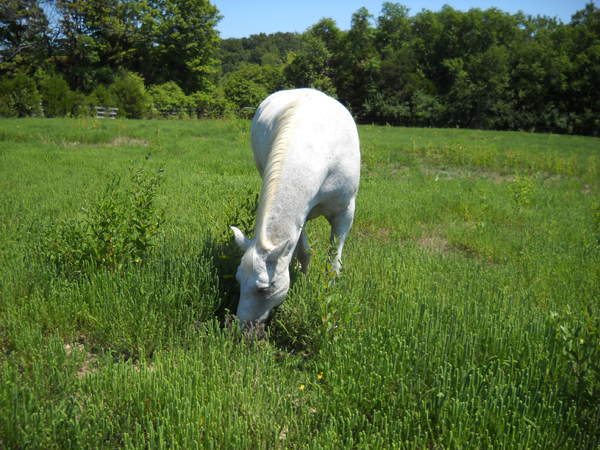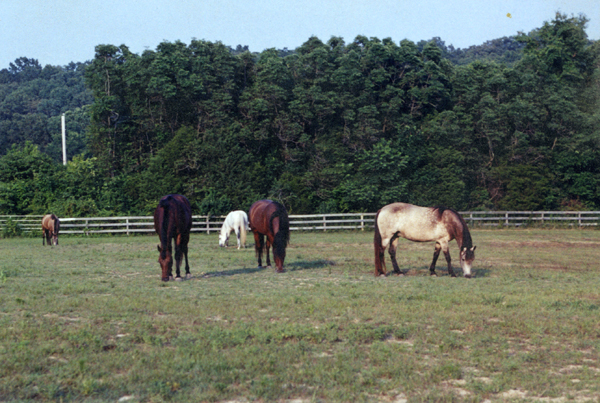Advice on pasture management for laminitic horses is often conflicting

Kurt picks through ragweed in the field by the house on Aug. 11, 2012.
For years, I was caught in the middle an argument over whether owners of laminitic horses should fertilize their pastures. On one side of the argument was my veterinarian, who specialized in laminitis and was opposed to fertilizer; on the other side was a plant scientist with laminitic horses of her own who had been studying the sugar content of grasses under various conditions and was in favor of fertilizer. She worked with my vet and at one point visited my farm.
The plant specialist said that fertilizing a stressed horse pasture would keep the plants healthier and the sugar level lower, making it safer for a laminitic horse.
The vet insisted that the fertilizer would increase grass production so much that the horse would get far more sugar from the extra plant growth than it would from an unfertilized pasture that had higher sugar levels due to stress.
My current vet agrees with the previous vet’s view: the less grass, the better, whether the grass is stressed or not.
My research over the past month suggests that there’s no right answer for pasture management for the laminitic horse. There is much conflicting advice. And doing nothing is not a good option, either.
The plant scientist was not shy in her assessment of the poor condition of my overgrazed, unfertilized pastures when she visited in 2007; she felt the pastures needed help. If I remember her instructions correctly, she wanted me to fertilize my pastures and fence them off into smaller pastures to rotate my horses on the grass as opposed to letting them have access to the full pastures all the time. I decided against dividing the pastures into smaller areas since their original purpose was to allow the horses to run; with each field being about 2 acres, the horses had limited ability to gallop already. I had four pastures; thus, I had the capacity to rotate the horses, if I wanted to rest each field. Plus, I was so laminitis-poor by that point that I had no money to add fencing anyway. A lot of decisions are made simply based on a lack of money.
These were not the only opinions about grass that I was weighing.
In 2004, after Angel foundered, a prominent laminitis veterinarian from Sweden visited my farm on a ride-a-long with my vet and said after hearing about my multiple laminitis cases: “I think you should move.” His rationale was that someone had put something in the soil over the years, whether through fertilizer or by planting a certain crop, that had created a condition that was ripe for a horse to develop laminitis, and it might take years for the makeup of the soil to change. Don’t I wish I had listened to him?
And, at the end of 2008, another prominent laminitis veterinarian from the Midwest came to my farm and said I should get rid of the grass completely. Since my whole farm slopes downward, and Missouri is prone to what we call “gully washer” storms, removing the grass cover seemed like a bad idea for that reason alone.
Getting back to the plant scientist’s advice — since I had one founder case after the next with my horses, the idea of adding fertilizer to any of the grass seemed too scary, so I wasn’t inclined to go that direction. I applied fertilizer only once in 2008 when trying to bring back a patch of pasture that had died after builders removed some dirt to erect my hay shed elsewhere. I applied fertilizer and grass seed to that stripped area with no results; it’s still brown. At the same time, I stupidly put the leftover fertilizer and grass seed on my septic area in the pasture by my house because the septic drain field was getting bare. Perhaps, not surprisingly, that summer was the first year that Robin Hood truly foundered.
According to Donna Foulk, former senior agriculture program coordinator at Rutgers Cooperative Extension, if you are going to fertilize your pasture, your horses should be removed. She says: Nitrogen fertilizer is toxic, and horses should not be allowed to graze pastures until rain has completely removed all of the fertilizer from the leaf surfaces and carried it into the soil. As a general rule, horses should be removed from fertilized pastures and not returned until at least a half inch of rainfall has occurred and the fertilizer is no longer visible on the soil surface. Best management practices dictate that after fertilizing pastures, horses should not be returned to the pastures for two to three weeks to provide ample time for the pasture grasses to grow and recover from grazing.
I didn’t pull the horses off the pasture when I put out the fertilizer. I didn’t put out much, but I didn’t remove the horses, either.
I have never applied weed killer to any of my pastures. I considered it in 2011, but, the vet mentioned at the top of this article cautioned that he wasn’t willing to put weed killer down in his own pastures out of concern for what it may do to the laminitic horses in his care. I’ve been basically paralyzed with fear and, hence, have done nothing about the continuing decline of my pastures.
As a result, I have a truly magnificent stand of ragweed that comes up every July now.

The five horses that grazed the field by the house in the early 2000s kept it bare, yet three of the horses — the mares — foundered at the time.
Oregon State University has a guide for pasture management on its site that says grass cutting, seeding, fertilizer and horse rotation are the main tools for maintaining quality pastures. Use of herbicide on a regular basis indicates that you are managing your pastures poorly, it says.
OK. So, I shouldn’t use herbicide. Then, what should I do?
Many university websites decry overgrazed pastures. But there’s no shortage of laminitis experts who say laminitic horses should be on dry lots, and even the university websites say horse owners should have a “sacrifice” area where the horses can hang out when the pastures are wet or overgrazed, lessening the damage to the pastures. I personally think there’s a very fine line between a dry lot and an overgrazed pasture. Would the pasture in my photo with the five horses grazing be considered a dry lot? Can you have less vegetation than that and not have considerable soil erosion?
Speaking of soil erosion, the pasture maintenance guide by the Oregon State University extension office is particularly harsh about keeping your horses on mud. It recommends sacrifice areas have an all-weather surface such as gravel or sand. On mud, it says: “Mud harbors bacteria and fungal organisms that cause health problems. Mud fever (or scratches) is a common condition that usually affects horses’ lower limbs. It is marked by inflammation of the skin and the appearance of crusty scabs. It usually is caused by bacteria that penetrate the skin following either damage or softening from exposure to wetness or mud. The bacteria thrive in wet, muddy conditions. On the upper body, the same condition is referred to as rain scald.”
At the end of all this research, I know nothing.